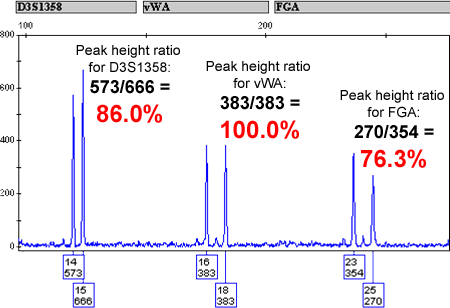Archival Notice
This is an archive page that is no longer being updated. It may contain outdated information and links may no longer function as originally intended.
Home | Glossary | Resources | Help | Contact Us | Course Map
The third step in the interpretation process is to assess the data from each sample. Laboratories take both qualitative and quantitative approaches to this assessment. Laboratory procedures should be based upon validation studies and provide a scientific foundation for data interpretation and reporting.
After determining if extraneous peaks interfere with interpretation, many laboratories assess the peak height percentages and determine the contribution from each donor in mixtures.
In order to use either of these estimations, the following should be established:
- The laboratory should conduct validation studies to establish a relative fluorescence unit (RFU) range within which consistent peak height percentages are obtained with the method(s) used. For example, low-level and/or degraded DNA may produce data at or around the threshold established by the laboratory. Many validation studies have demonstrated that consistent peak height percentages cannot be obtained at low RFUs.
- The laboratory should conduct validation studies to establish minimum donor contribution. For example, many laboratories have determined that, for a two person mixture, the minor donor must contribute at least 10% in order to be reliably assessed.
Peak Height Percentage
Under optimum conditions (sufficient quantity and quality of DNA), heterozygous peaks within a locus should be similar in height or intensity to each other. In general, heterozygous alleles have peak heights that are within 70% of each other, but laboratories should conduct validation studies to determine an appropriate peak height percentage for the method(s) used.
The peak height percentage for two heterozygous peaks is determined by dividing the peak height of the smaller peak by the peak height of the larger peak. The result is then expressed as a percentage, and is referred to as the peak height percentage.
Many things can affect heterozygous peak height percentages. Data from samples with low-level and/or degraded DNA may have peak height percentages much lower than 70%. In addition, the composition of the muliplex, to include the size of the multiplex, can affect the percentage. Laboratories should use their validation studies to determine an acceptable peak height percentage range for both single source and mixed DNA sample data interpretation.
Note: |
|---|
| The peak area can be used in place of peak height. |
Additional Online Courses
- What Every First Responding Officer Should Know About DNA Evidence
- Collecting DNA Evidence at Property Crime Scenes
- DNA – A Prosecutor’s Practice Notebook
- Crime Scene and DNA Basics
- Laboratory Safety Programs
- DNA Amplification
- Population Genetics and Statistics
- Non-STR DNA Markers: SNPs, Y-STRs, LCN and mtDNA
- Firearms Examiner Training
- Forensic DNA Education for Law Enforcement Decisionmakers
- What Every Investigator and Evidence Technician Should Know About DNA Evidence
- Principles of Forensic DNA for Officers of the Court
- Law 101: Legal Guide for the Forensic Expert
- Laboratory Orientation and Testing of Body Fluids and Tissues
- DNA Extraction and Quantitation
- STR Data Analysis and Interpretation
- Communication Skills, Report Writing, and Courtroom Testimony
- Español for Law Enforcement
- Amplified DNA Product Separation for Forensic Analysts


